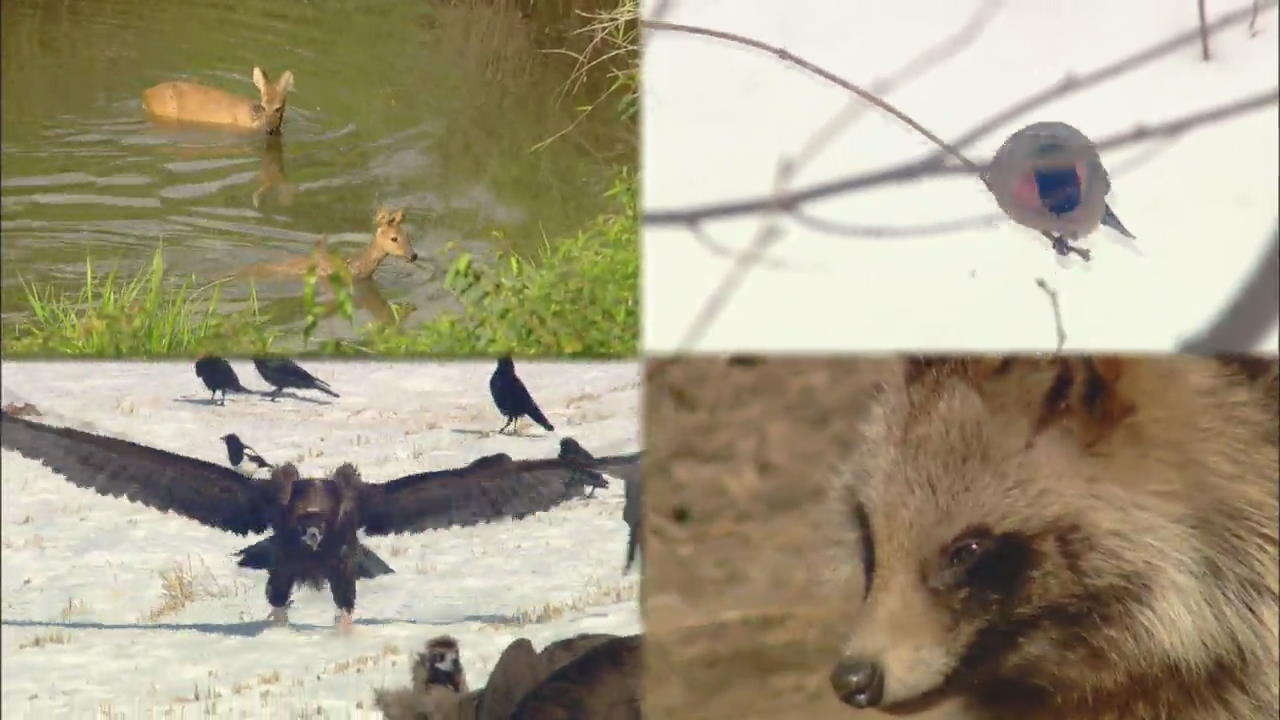DMZ Ecology Survey
입력 2016.12.09 (14:21)
수정 2016.12.09 (16:28)
읽어주기 기능은 크롬기반의
브라우저에서만 사용하실 수 있습니다.
[Anchor Lead]
A survey has found that the Demilitarized Zone on the Korean Peninsula is home to more than 4,800 species of flora and fauna. The survey summarizes the results of various studies conducted over the past four decades.
[Pkg]
The 240km long Demilitarized Zone crossing the central part of the Korean Peninsula has been off limits to the public for more than six decades. A flock of cranes, which are a Class I endangered species, flies gracefully early in the morning. The birds look for food in a frozen field as they prepare for the winter. Black swans, another endangered species, swim peacefully in a lake.The DMZ has been found to be home to more than 300 Asiatic black bears, which struggle to survive in the nation's southern regions. An adorable marten climbs onto a tree and curiously checks its surroundings. A leopard cat, known to be a fierce predator, catches prey in a winter field and enjoys it at its leisure. Although the DMZ accounts for just 1.6 percent of the Korean Peninsula's total area, it's home to 4,873 species of animals and plants, accounting for 20 percent of the total number of species.
[Soundbite] Choi Tae-young(Nat'l Institute of Ecology) : "91 species, or 41 percent of the total of 222 wild endangered species, live in this area.This shows once again that the DMZ is a haven of biodiversity in Korea."
The DMZ is best known as a symbol of national division, but to plants and animals living on the Korean Peninsula it is a treasured home.
A survey has found that the Demilitarized Zone on the Korean Peninsula is home to more than 4,800 species of flora and fauna. The survey summarizes the results of various studies conducted over the past four decades.
[Pkg]
The 240km long Demilitarized Zone crossing the central part of the Korean Peninsula has been off limits to the public for more than six decades. A flock of cranes, which are a Class I endangered species, flies gracefully early in the morning. The birds look for food in a frozen field as they prepare for the winter. Black swans, another endangered species, swim peacefully in a lake.The DMZ has been found to be home to more than 300 Asiatic black bears, which struggle to survive in the nation's southern regions. An adorable marten climbs onto a tree and curiously checks its surroundings. A leopard cat, known to be a fierce predator, catches prey in a winter field and enjoys it at its leisure. Although the DMZ accounts for just 1.6 percent of the Korean Peninsula's total area, it's home to 4,873 species of animals and plants, accounting for 20 percent of the total number of species.
[Soundbite] Choi Tae-young(Nat'l Institute of Ecology) : "91 species, or 41 percent of the total of 222 wild endangered species, live in this area.This shows once again that the DMZ is a haven of biodiversity in Korea."
The DMZ is best known as a symbol of national division, but to plants and animals living on the Korean Peninsula it is a treasured home.
■ 제보하기
▷ 카카오톡 : 'KBS제보' 검색, 채널 추가
▷ 전화 : 02-781-1234, 4444
▷ 이메일 : kbs1234@kbs.co.kr
▷ 유튜브, 네이버, 카카오에서도 KBS뉴스를 구독해주세요!
- DMZ Ecology Survey
-
- 입력 2016-12-09 14:24:36
- 수정2016-12-09 16:28:26

[Anchor Lead]
A survey has found that the Demilitarized Zone on the Korean Peninsula is home to more than 4,800 species of flora and fauna. The survey summarizes the results of various studies conducted over the past four decades.
[Pkg]
The 240km long Demilitarized Zone crossing the central part of the Korean Peninsula has been off limits to the public for more than six decades. A flock of cranes, which are a Class I endangered species, flies gracefully early in the morning. The birds look for food in a frozen field as they prepare for the winter. Black swans, another endangered species, swim peacefully in a lake.The DMZ has been found to be home to more than 300 Asiatic black bears, which struggle to survive in the nation's southern regions. An adorable marten climbs onto a tree and curiously checks its surroundings. A leopard cat, known to be a fierce predator, catches prey in a winter field and enjoys it at its leisure. Although the DMZ accounts for just 1.6 percent of the Korean Peninsula's total area, it's home to 4,873 species of animals and plants, accounting for 20 percent of the total number of species.
[Soundbite] Choi Tae-young(Nat'l Institute of Ecology) : "91 species, or 41 percent of the total of 222 wild endangered species, live in this area.This shows once again that the DMZ is a haven of biodiversity in Korea."
The DMZ is best known as a symbol of national division, but to plants and animals living on the Korean Peninsula it is a treasured home.
A survey has found that the Demilitarized Zone on the Korean Peninsula is home to more than 4,800 species of flora and fauna. The survey summarizes the results of various studies conducted over the past four decades.
[Pkg]
The 240km long Demilitarized Zone crossing the central part of the Korean Peninsula has been off limits to the public for more than six decades. A flock of cranes, which are a Class I endangered species, flies gracefully early in the morning. The birds look for food in a frozen field as they prepare for the winter. Black swans, another endangered species, swim peacefully in a lake.The DMZ has been found to be home to more than 300 Asiatic black bears, which struggle to survive in the nation's southern regions. An adorable marten climbs onto a tree and curiously checks its surroundings. A leopard cat, known to be a fierce predator, catches prey in a winter field and enjoys it at its leisure. Although the DMZ accounts for just 1.6 percent of the Korean Peninsula's total area, it's home to 4,873 species of animals and plants, accounting for 20 percent of the total number of species.
[Soundbite] Choi Tae-young(Nat'l Institute of Ecology) : "91 species, or 41 percent of the total of 222 wild endangered species, live in this area.This shows once again that the DMZ is a haven of biodiversity in Korea."
The DMZ is best known as a symbol of national division, but to plants and animals living on the Korean Peninsula it is a treasured home.
이 기사가 좋으셨다면
-
좋아요
0
-
응원해요
0
-
후속 원해요
0












![[속보] 경기 연천군에서 규모 3.3 지진](/data/layer/904/2025/05/20250510_kTO1cb.jpg)




이 기사에 대한 의견을 남겨주세요.